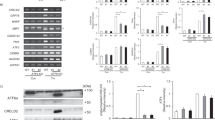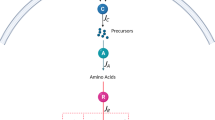Abstract
We have cloned and characterized the HSP150 gene of Saccharomyces cerevisiae, which encodes a glycoprotein (hsp150) that is secreted into the growth medium. Unexpectedly, the HSP150 gene was found to be regulated by heat shock and nitrogen starvation. Shifting the cells from 24° C to 37° C resulted in an abrupt increase in the steady-state level of the HSP150 mRNA, and de novo synthesized hsp150 protein. Returning the cells to 24° C caused a rapid decrease in mRNA and protein synthesis to basal levels. The HSP150 5′-flanking region contains several heat shock element-like sequences (HSE). To study the function of these sequences, a strain bearing a disrupted copy of the HSP150 gene was transformed with plasmids in which the coding region of HSP150, or a HSP150-lacZ fusion gene, was preceded by 5′ deletion derivatives of the HSP150 promoter. Site-directed mutagenesis of one HSE-like element, located between the TATA box and transcription initiation sites, abolished heat activation of transcription. In addition to heat shock, the HSP150 gene is regulated by the availability of nutrients in the growth medium. The HSP150 mRNA level was increased by nitrogen limitation at 24° C, even when under the control of a HSP150 promoter region of 137 by carrying the mutagenized HSE.
Similar content being viewed by others
References
Amin J, Ananthan J, Voellmy R (1988) Key features of heat shock regulatory elements. Mol Cell Biol 8:3761–3769
Belazzi T, Wagner A, Wieser R, Schanz M, Adam G, Harting A, Ruis H (1991) Negative regulation of transcription of the Saccharomyces cerevisiae catalase T (CTTI) gene by CAMP is mediated by a positive control element. EMBO J 10:585–592
Bissinger PH, Wieser R, Hamilton B, Ruis H (1989) Control of Saccharomyces cerevisiae catalase T gene (CTTI) expression by nutrient supply via the RAS-cyclic AMP pathway. Mol Cell Biol 9:1309–1315
Boorstein W, Craig EA (1990) Transcriptional regulation of SSA3, an HSP70 gene from Saccharomyces cerevisiae. Mol Cell Biol 10:3262–3267
Broach JR, Deschenes RJ (1991) The function of RAS genes in Saccharomyces cerevisiae. Adv Cancer Res 54:79–139
Craig EA, Jakobsen K (1985) Mutations in cognate genes of Saccharomyces cerevisiae hsp70 result in reduced growth rates at low temperatures. Mol Cell Biol 5:3517–3524
Feinberg AP, Vogelstein B (1983) A technique for radiolabeling DNA restriction endonuclease fragments to high specific activity. Anal Biochem 132:6–13
Gallwitz D, Sures I (1980) Structure of a split gene: complete nucleotide sequence of the actin gene in Saccharomyces cerevisiae. Proc Natl Acad Sci USA 77:2546–2550
Gimeno CJ, Ljungdahl PO, Styles CA, Fink G (1992) Unipolar cell divisions in the yeast S. cerevisiae lead to filamentous growth: regulation by starvation and RAS. Cell 68:1077–1090
Jakobsen BK, Pelham HRB (1988) Constitutive binding of yeast heat shock factor to DNA in vivo. Mol Cell Biol 8:5040–5042
Jakobsen BK, Pelham HRB (1991) A conserved heptapeptide restrains the activity of the yeast heat shock transcription factor. EMBO J 10:369–375
Kobayashi N, McEntee K (1990) Evidence for a heat shock transcription factor-independent mechanism for heat shock induction of transcription in Saccharomyces cerevisiae. Proc Natl Acad Sci USA 87:6550–6554
Li WZ, Sherman F (1991) Two types of TATA elements for the CYCI gene of the yeast Saccharomyces cerevisiae. Mol Cell Biol 11:666–676
Lindquist S, Craig EA (1988) The heat shock proteins. Annu Rev Genet 22:631–677
Matsumoto K, Uno I, Ishikawa T (1985) Genetic analysis of the role of CAMP in yeast. Yeast 1:15–24
Maxam AM, Gilbert W (1980) Sequencing end-labeled DNA with base-specific chemical cleavages. Methods Enzymol 65:499–560
Munro S, Pelham HRB (1986) An Hsp70-like protein in the ER: identity with the 78 kD glucose-regulated protein and immunoglobulin heavy chain binding protein. Cell 46:291–300
Myers AM, Tzagoloff A, Kinney DM, Lusty CJ (1986) Yeast shuttle and integrative vectors with multiple cloning sites suitable for construction of lacZ fusions. Gene 45:299–310
Paakkola J, Sareneva H, Russo P, Makarow M (1990) A heatregulated secretory glycoprotein in Saccharomyces cerevisiae. Yeast 6:499
Park H-O, Craig EA (1989) Positive and negative regulation of basal expression of a yeast HSP70 gene. Mol Cell Biol 9:2025–2033
Praekelt UM, Meacock PA (1990) HSP12, a new small heat shock gene of Saccharomyces cerevisiae: analysis of structure, regulation and function. Mol Gen Genet 223:97–106
Rothstein R (1991) Targetting, disruption, replacement and allele rescue: integrative DNA transformation in yeast. Methods Enzymol 101:202–211
Russo P, Sherman F (1989) Transcription terminates near the poly(A) site in the CYCI gene of the yeast Saccharomyces cerevisiae. Proc Natl Acad Sci USA 86:8348–8352
Russo P, Li WZ, Hampsey DM, Zareth K, Sherman F (1991) Distinct cis-acting signals enhance 3′ end point formation of CYCI mRNA in the yeast Saccharomyces cerevisiae. EMBO J 10:563–571
Russo P, Kalkkinen N, Sareneva H, Paakkola J, Makarow M (1992) A heat shock gene from Saccharomyces cerevisiae encoding a secretory glycoprotein. Proc Natl Acad Sci USA 89:3671–3675. Correction 89:8857
Sambrook J, Fritsch EF, Maniatis T (1989) Molecular cloning: A laboratory manual. Cold Spring Harbor Laboratory Press, Cold Spring Harbor, New York
Sanger F, Nicklen S, Coulson AR (1977) DNA sequencing with chain-terminating inhibitors. Proc Natl Acad Sci USA 74:5463–5467
Sherman F (1991) Getting started with yeast. Methods Enzymol 194:3–20
Sherman F, Fink GR, Hick JB (1986) Methods in yeast genetics. Cold Spring Harbor Laboratory Press, Cold Spring Harbor, New York
Sikorski RS, Hieter P (1989) A system of shuttle vectors and yeast host strains designed for efficient manipulation of DNA. Genetics 122:19–27
Slater MR, Craig EA (1989) The SSA1 and SSA2 genes of the yeast Saccharomyces cerevisiae. Nucleic Acids Res 17:805–806
Sorger PK, Pelham HRB (1987) Purification and characterization of a heat-shock element binding protein from yeast. EMBO J 6:3035–3041
Sorger PK, Pelham HRB (1988) Yeast heat shock factor is an essential DNA-binding protein that exhibits temperature-dependent phosphorylation. Cell 54:855–864
Sorger PK, Lewis MJ, Pelham HRB (1987) Heat shock factor is regulated differently in yeast and HeLa cells. Nature 329:81–84
Tanaka K, Matsumoto K, Toh-e A (1988) Dual regulation of the expression of the polyubiquitin gene by cyclic AMP and heat shock in yeast. EMBO J 7:495–502
Thevelein JM (1991) Fermentable sugars and intracellular acidification as specific activators of the RAS-adenylate cyclase signalling pathway in yeast: the relationship to nutrient-induced cell cycle control. Mol Microbiol 5:1301–1307
Toda T, Uno I, Ishikawa T, Powers S, Kataoka T, Brock D, Cameron S, Broach J, Matsumoto K, Wigler M (1985) In yeast, the Ras proteins are controlling elements of adenylate cyclase. Cell 40:27–36
Werner-Washburne M, Becker J, Kosic-Smithers J, Craig EA (1989) Yeast Hsp70 RNA levels vary in response to the physiological status of the cell. J Bacteriol 171:2680–2688
Wieser R, Adam G, Wagner A, Schüller C, Marchler G, Ruis H, Krawiec Z, Bilinski T (1991) Heat shock factor-independent heat control of transcription of the CTTI gene encoding the cytosolic catalase T of Saccharomyces cerevisiae. J Biol Chem 266:12406–12411
Xiao H, Lis JT (1988) Germline transformation used to define key features of heat-shock response elements. Science 239:1139–1142
Author information
Authors and Affiliations
Additional information
Communicated by C.P. Hollenberg
Rights and permissions
About this article
Cite this article
Russo, P., Simonen, M., Uimari, A. et al. Dual regulation by heat and nutrient stress of the yeast HSP150 gene encoding a secretory glycoprotein. Molec. Gen. Genet. 239, 273–280 (1993). https://doi.org/10.1007/BF00281628
Received:
Accepted:
Issue Date:
DOI: https://doi.org/10.1007/BF00281628




